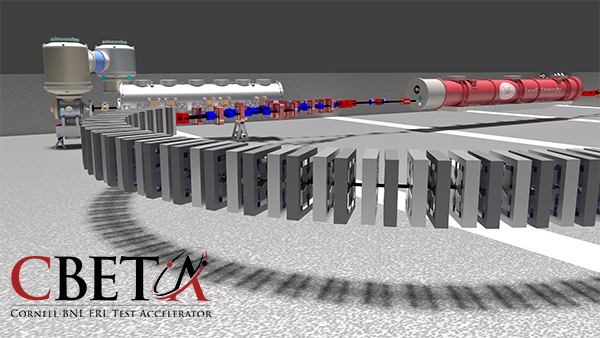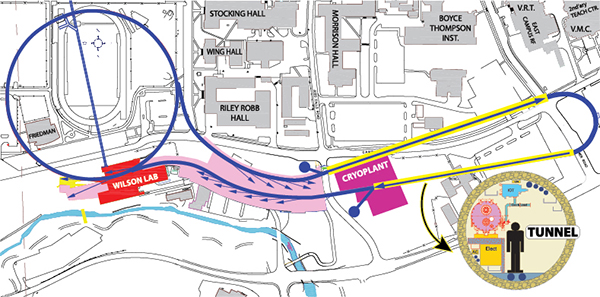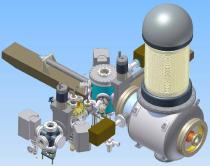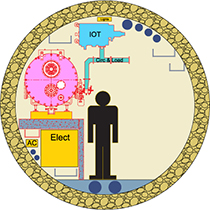ERL Research at Cornell
 Since 2005, Cornell University has been funded to perform basic research for a new type of particle accelerator, the Energy Recovery Linac (ERL). Over the years, funding has been provided by the National Science Foundation, the Department of Energy, New York State, as well as the industrial companies ASML and AES.
Since 2005, Cornell University has been funded to perform basic research for a new type of particle accelerator, the Energy Recovery Linac (ERL). Over the years, funding has been provided by the National Science Foundation, the Department of Energy, New York State, as well as the industrial companies ASML and AES.
How it works
While the current in conventional linear accelerators (linacs) is limited by the beam-power that they can be fed by the power grid, and while circular accelerators degrade the beam quality within millions of turns around the ring, ERLs are a hybrid between rings and linacs, reaching currents as large as those in rings with beam qualities as large as for linacs. This is achieved by accelerating a high-quality beam in a linac and to recover its energy by deceleration. This energy is then used to accelerate new high-quality beam in the linac. Because the beam's power is recaptured, the current is no longer limited by the power from the grid. For more details, please contact the Cornell PI Prof. Georg Hoffstaetter.
The current research emphasis (Principle Investigator Prof. Georg Hoffstaetter) is the design and construction of the Cornell-BNL ERL Test Accelerator (CBETA) where Cornell physicists, working with Brookhaven National Lab, are developing the world's first multi-turn ERL with Superconducting Radio Frequency (SRF) acceleration and energy saving permanent magnet beam transport (called FFAR) for multiple beams in the same pipe. Components of this accelerator are based on research in DC guns and photo-cathodes (Principle Investigator Prof. Ivan Bazarov) and SRF accelerators (Principle Investigator Matthias Liepe). Cornell University has prototyped technology essential for CBETA, including a DC gun and an SRF injector Linac with world-record current and normalized brightness in a bunch train, a high-current CW cryomodule for up to 70 MeV energy gain, a high-power beam stop, and several diagnostics tools for high-current and high-brightness beams, e.g. a beamline for measuring 6-D phase-space densities, a fast wire scanner for beam profiles, and beam loss diagnostics. All these are now available to equip a one-cryomodule ERL and will be utilized for CBETA. Within the next several years, CBETA will develop into a powerhouse of accelerator physics and technology, and will be one of the most advanced on the planet (earth). When this prototype ERL is complete and expanded upon, it will be a critical resource to New York State and the nation, propelling accelerator R&D. This will impact all high-power accelerators, with applications from biomedical advancement to basic physics and from computer-chip lithography to material science, driving discoveries and economic development. CBETA will recirculate multiple beams of different energies around the accelerator at one time. The electrons will make four accelerating passes around the accelerator, while building up energy as they pass through the cryomodule. In four more passes, they will return to the superconducting cavities that accelerated them and return their energy back to these cavities - hence it is an Energy Recovery Linac (ERL). While this method conserves energy, it also creates beams that are tightly bound and are a factor of 1,000 times brighter than current sources.
Before the start the CBETA project, a hard-x-ray ERL was designed and its components were prototyped. The design of this hard-x-ray ERL was made cost efficient by reusing as much infrastructure of the existing CESR ring as beneficial. The operation of CHESS should be disrupted as little as possible while building and commissioning the ERL, and the facility should provide space for a sufficient number of X-ray beam lines. While it could have turned out that reusing CESR imposes too many constraints, quite contrary it has been found that the flexibility of CESR's magnet arrangement holds several advantages for an ERL design. In order to extend the space for cavities, to make space for possible upgrades, and to minimize the impact on CHESS operation, the layout in the figure below has been devised.

Cornell's ERL design reuses the existing half-mile circumference underground synchrotron tunnel (the blue circle). The linear extensions to the right of the circle are additional tunnels containing two superconducting linear accelerators. The arrows show positions of x-ray stations that will be used by scientists and engineers from around the world.
 The ERL injector will produce 100 mA low-emittance beams.
The ERL is a single-pass machine which means the low-emittance beams must be produced at injection and not through synchrotron radiation damping. This puts demanding requirements on the electron gun used in the ERL. The injector will be a DC photoemission electron gun and will provide high-current, low-emittance electron beams.
The ERL photoinjector has been optimized in simulations and is now being constructed on-site at Wilson Laboratory. The ERL injection system also involves five superconducting niobium cavities to accelerate the beam from 500 keV to 15 MeV. This complete high-power SRF linac has been optimized and fabricated at Cornell. Similarly, the complete main SRF linac of the ERL was designed and constructed at Cornell.
The ERL injector will produce 100 mA low-emittance beams.
The ERL is a single-pass machine which means the low-emittance beams must be produced at injection and not through synchrotron radiation damping. This puts demanding requirements on the electron gun used in the ERL. The injector will be a DC photoemission electron gun and will provide high-current, low-emittance electron beams.
The ERL photoinjector has been optimized in simulations and is now being constructed on-site at Wilson Laboratory. The ERL injection system also involves five superconducting niobium cavities to accelerate the beam from 500 keV to 15 MeV. This complete high-power SRF linac has been optimized and fabricated at Cornell. Similarly, the complete main SRF linac of the ERL was designed and constructed at Cornell.
The beam current in the ERL is limited by an unstable increase of ElectroMagnetic (EM) fields in the linac cavities. This is called the beam breakup (BBU) instability and is being studied here at Cornell. Theoretical and simulation studies of the BBU in the ERL are being developed, including the effects of a feedback system. Other electromagnetic fields exert nonlinear forces on the beam. These fields come from a variety of sources including the individual bunch particles (space charge), the synchrotron radiation from one part of the bunch shining on another part (coherent synchrotron radiation), and the fields excited in the RF cavity (wake fields). All of these EM fields cause the small emittance of the electron bunches to be increased beyond a useful size for a high-brightness x-ray source. Mitigation techniques of these disrupting EM fields are being studied in simulations at Cornell.
Quick Links
- ERL Group Home
- ERL Introduction
- ERL Research at Cornell
- ERL News
- ERL Workshops
- ERL Publications
- CBETA

